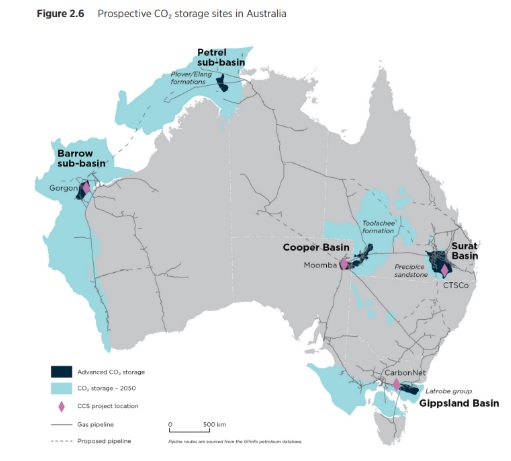There is renewed interest in Carbon Capture (Utilisation) and Storage (CCUS or CCS) projects and investment opportunities in Australia. The Australian Government has signalled strong support for innovative solutions to decarbonise the Australian economy. Commercialisation of the industry is being supported by federal funding as part of Australia's long-term emissions reduction plan.
For example, in the Federal Budget 2022-2023 the Australian Government has allocated:
- $50.3 million over 2 years from 2022-23 to accelerate the
development of priority gas infrastructure projects consistent with
the Future Gas Infrastructure Investment Framework and support
investment in carbon capture and storage pipeline infrastructure;
and
- up to $20 million to support CarbonNet's Stage 3 activities, as it aims to establish a commercial carbon capture and storage network in Victoria's Gippsland Basin.
CCS must play a vital role in decarbonising the economy in order to limit temperature increases to the Paris Agreement goal of 1.5 degrees Celsius. The International Energy Agency declared in its 2020 flagship report that "reaching net zero goals without CCS will be almost impossible".
CCS is seen as a crucial component in:
- reducing emissions of hard to abate industries such as gas
production;
- supporting the development of other low emissions technologies
for example, blue hydrogen; and
- producing carbon credits as part of Australia's Emissions Reduction Fund.
CCS is not new - it has been around since the 1970s. It was first used as a means to increase oil yields, rather than to combat carbon emissions. CCS projects have experienced difficulties particularly in achieving performance targets. Performance issues and outages saw the Petra Nova CCS project in Texas, USA, shut down after only three years in operation.
The technology is improving and is increasingly being considered for modest scale projects such as energy from waste facilities. Large scale CCS projects are still to be proven commercially and technically viable.
This Insight considers the barriers to entry and opportunities for large scale CCS projects in the Australian market.
Barriers to entry
Long-term environmental liability and bonding
CCS projects are generally long term in nature, exposing operators to significant liability over extended periods.
Achieving stabilisation and the risk of leakage of stored carbon may become a real problem, according to some members in the scientific community. Another issue to navigate is liability post-closure of a CCS site, when an operator will not be taking revenue from the project.
As a result, establishing clear and commercially viable liability regimes will be critically important in the development of large scale CCS projects.
As happens in the minerals and petroleum industries, regulators may require CCS operators to take out bonds, or maintain insurance against expenses and liabilities associated with the CCS project. For example, section 218 of the Greenhouse Gas Geological Sequestration Act 2008 (Vic), requires the licensee to procure a bond to secure payment for any rehabilitation work, clean-up work or pollution prevention work that may be necessary.
Bonds may not be appropriate in respect of long-term monitoring, since bonds are often partially refunded when certain conditions are met. In 2007 the Federal Standing Committee on Science and Innovation recognised the need for regulation to be flexible and robust given storage may be for hundreds or thousands of years. Bonds may also not be appropriate in all circumstances, as they involve high transaction costs, and impose liquidity constraints on the industry operators who take them out.
One approach is for financial liability and responsibility to rest with industry operators while the CCS facility is operational. This would be followed by a period of joint liability (shared between the industry operator and state and Australian governments). Full liability would then ultimately lie with the government(s) in perpetuity once certain conditions had been met, for example stabilisation of the carbon.
At least one government seems prepared to do this. Former WA Minister for Mines and Petroleum, Bill Marmion, stated that it is commonly recognised across state and federal governments that the long-term liability of CCS will ultimately fall on governments. This was qualified by the relevant government being satisfied with the stored greenhouse gas and completion of a site closure process. Under the Barrow Island Act 2003 (WA), the State Government agreed to indemnify parties against post-closure liability for any loss or damage caused by the injection of carbon dioxide.
Take away
During the operational phase, operators must be prepared to assume environmental liability and expect bonding requirements. Post-closure liability is likely to be assumed by government subject to certain pre-conditions being met.
Co-ordination across state borders
Commonwealth CCS laws only apply to offshore areas within the Commonwealth's jurisdiction. It is then left to the state governments to legislate for onshore CCS, and those offshore, but within their state-waters. Co-ordination across state borders is vital to ensure that CCS projects can operate on a larger scale.
Currently, most proposed CCS projects are co-located with the greenhouse gas emitting industry. However, as pipeline infrastructure is expanded there is scope for CCS projects to cross state and territory borders.
The Commonwealth
The Commonwealth regulates CCS under the Offshore Petroleum and Greenhouse Gas Storage Act 2006 (Cth) (OPGGSA). The OPGGSA supports CCS projects by allowing parties to obtain permits to explore for suitable geological formations for gas storage, injection licences, and declarations from the Minister for Resources that an area is appropriate for gas storage.
The OPGGSA also provides for rehabilitation and restoration of CCS sites.
The National Offshore Petroleum Safety and Environmental Management Authority (NOPSEMA) is responsible for approving and enforcing the environmental plans for CCS projects, and has extensive power to issue remedial directions to CCS operators. The environmental plan for CCS projects must be approved before any activity can be commenced by the operator.
Victoria, Queensland and South Australia
Victoria, Queensland and South Australia have legislation in place similar to the Commonwealth, for the storage of greenhouse gas (as part of, or separate to, legislation regulating petroleum activities).
In Queensland CCS is considered to be an environmentally relevant activity under the Environmental Protection Act 1994 (Qld), which requires environmental approval.
New South Wales and Western Australia
Both states have prepared bills to regulate CCS but these have not passed. In March 2022, the WA Government announced that a Greenhouse Gas Storage and Transport Bill will be drafted, to assist in the decarbonisation of the resource industry and to help WA reach net zero emissions by 2050. The bill will establish a legal framework for CCS.
Consultation with the resources industry and wider community will be undertaken before the bill is finalised. There is opportunity in WA, particularly for transport and storage operators, to influence important issues such as liability regimes through this consultation process.
Take away
A national framework is needed to cover issues such as transport, injection, monitoring and liability throughout the various stages of CCS. Such a framework would facilitate flexibility and allow carbon dioxide produced in one state to be stored in another, if that is where long-term storage is most appropriate.
Opportunities
Long-term stretch goal
CCS technology and investment has been identified by the federal government as a priority to assist Australia in meeting its Nationally Determined Contributions under the Paris Agreement. In 2020, the Commonweatlh Government announced in its First Low Emissions Technology Statement that 'large-scale deployment of CCS" is a priority that will "underpin new low emissions industries".
The Government then published a long-term emissions reduction plan in 2021, in which it stated that it was committing over $300 million for CCS technologies to be developed, and again identified CCS as a 'priority low emissions technology'.
The Government has also recognised that scaling CCS will support emissions reduction from the more commonly known greenhouse gas emitters including power generation, oil and gas extraction and natural gas processing. However, importantly, it also recognises that it will support hydrogen production, which is another cornerstone of the Government's low emissions reduction plan.
Take away
The Australian Government is invested in commercialising CCS to support its Paris Agreement commitments.
Offsets
Utilising CCS for offsets and creating carbon credits will be essential to making the technology economically viable.
In October 2021, as part of the Emissions Reduction Fund (ERF) framework, the Commonwealth Government announced the Carbon Credits (Carbon Farming Initiative- Carbon Capture and Storage) Methodology Determination 2021. This methodology determination awards one Australian Carbon Credit Unit (ACCU) for every tonne of carbon avoided or stored as a result of a CCS project.
The methodology determination sets out the rules for calculating and crediting greenhouse gas abatement from CCS activities, and sets out the rules for determining the eligibility of projects to be credited.
ACCUs will become an increasingly valuable commodity that will support the commercialisation of the CCS sector. Relevantly:
- In September 2021, ACCUs hit a 'record high' price of
$18.88 mtC02e driven by strong demand from governments and
commercial buyers (note that prices have since fallen);
- There is an increasing sophistication of the carbon market
through the development of exchanges, for example, the proposal for
an Australian Carbon Exchange by the Clean Energy Regulator;
- Australian corporations are striving to achieve their own net
zero targets and maintain social licence to operate. While for many
the current framework is voluntary, companies can meet those
objectives through the purchase of ACCUs as a means to reduce their
carbon footprint; and
- Large emitters will increasingly be reliant on the purchase and retirement of ACCUs to meet their baseline emission requirements under the ERF safeguard mechanism.
Co-location
Australia is home to several 'world-class geological storage basins' close to industries producing greenhouse gas emissions. This means that the storage of carbon can take place in proximity to its production for oil and gas industries.
It also means that the infrastructure (such as pipelines) required for CCS projects is already in place. Using existing infrastructure is highly desirable and consistent with the overall environmental objectives and lowers the cost and environmental impact of the CCS project.
These co-located industries will be used as the platform for further expansion of CCS in Australia and assist in the development of technology and appropriate regulation in the various states and territories.

Figure 2.6 sourced from Australia's whole-of-economy Long Term Emissions Reduction Plan – Figure ES.5 – Australian Government Department of Industry, Science, Energy and Resources
Conclusion
Australia is technically well placed to lead in the development of large scale CCS projects. The continued support of government is critical to ensuring the commercial viability of CCS projects.
With the Federal election looming, there are varying degrees of enthusiasm for CCS from each of the major political parties:
- The ALP has broadly expressed support for increased investment
in carbon capture and storage technologies as one component of a
broader strategy. In November 2021, Chris Bowen MP has however
indicated that CCS is "not the answer to all our
problems" and is "not an excuse not to reduce
emissions"; and
- The Liberal Government to date has announced a $500 million package to be provided to the Clean Energy Finance Corporation, to be accompanied by legislative amendments expanding the remit of the Corporation to enable it to invest in CCS. CCS has been pinpointed by the Liberal Government as a priority technology under its Technology Investment Roadmap and long-term emissions reduction plan, with $300 million allocated for the development of CCS.
The content of this article is intended to provide a general guide to the subject matter. Specialist advice should be sought about your specific circumstances.
 |
 |
| Lawyers Weekly
Law firm of the year
2021 |
Employer of Choice for Gender Equality
(WGEA) |



